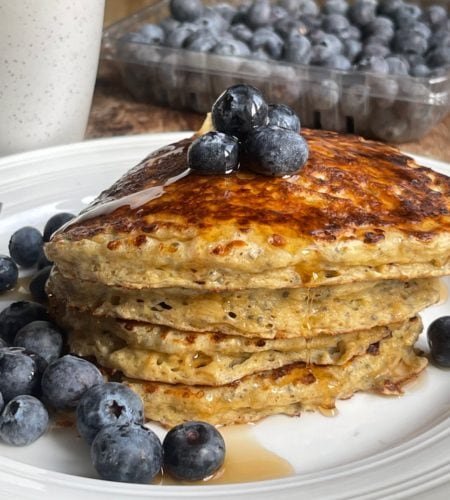Tips on Making Sourdough Bread
In 2020 at the beginning of lock down it seemed everyone was jumping on the sourdough bandwagon. Myself included. I sent away for a powdered starter, rehydrated, took a zoom class, made exactly ONE loaf of bread, it didn’t turn out so I gave up. Here are my tips on making sourdough bread at home.
If this sounds similar to your sourdough journey, I am here to help you with what I have learned this year.
What kind of flour to use?
There are so many amazing bread bakers out there, and everyone has their own spin on sourdough bread. Some only use rye or einkorn flour for their starters.
Immediately I knew I wasn’t going to do that. The reason being is I couldn’t think of a way I would use those flours in anything but bread, but I would use all purpose bread, so that’s what I use for both my starter and bread recipes. Be sure to use unbleached all purpose flour as well.
Unbleached flour is recommended for sourdough because it’s less processed and retains more of its natural nutrients. The bleaching process involves chemicals that can remove some of the key nutrients that sourdough starter relies on to thrive. The wild yeast and beneficial bacteria in sourdough need those nutrients to grow properly and develop the complex flavors and textures that are characteristic of sourdough bread.
Using unbleached flour helps ensure your starter stays active, healthy, and robust, which in turn leads to better fermentation and a more flavorful, airy loaf.
The starter recipe that I use is from The Clever Carrot. She has an amazing step-by-step tutorial on how to get your starter going. My house is typically cold, so I bought a seed mat to help my starter grow and that works amazingly well. You can find it here on Amazon for around $16.
When you are ready to make bread.
My starter is kept in my refrigerator, and has been there since I got it going in February of this year. It even sat in my refrigerator in an airtight container for nearly three months over the summer. There is something called “hooch” that will be on top of your starter, it kind of looks like grey water. That’s okay! Simply pour it off and feed your dough.
I aggressively feed my dough when I am ready to bake bread. Whatever amount of starter I have (I don’t measure it) I add 100 grams of flour and 100 grams of water. Stir until well mixed, place on your seed mat and within a few hours your starter should have doubled. A sure fire way to know when your starter is strong enough to make bread is to do the “float test.” Simply fill a glass with water, take a bit of starter and place it in the glass. If the starter floats you are good to go. If it sinks to the bottom, let the starter alone for another hour and do the float test again until ready to use.
This is controversial.
Once you are able to make the bread, after the fourth stretch and fold, I cover with a tea towel and let the dough sit on my counter overnight. THIS IS CONTROVERSIAL. Many people have told me that I am not getting the cold fermentation if I do it this way, but it works for me. In the morning, I divide the dough, shape into my loaves and place in two bowls and cover with plastic wrap. Let chill for five hours. At the four hour mark is when I preheat my dutch oven. Score the dough as you wish, bake with the lid on for 20 minutes, remove the lid and bake an additional 20 minutes. My oven temp is 475.
The recipe card below is for my “cheater” sourdough bread, which adds active yeast to give you a full proof way to get your sourdough to not only rise, but taste amazing. While the steps may seem complicated, this is really only about 15 minutes of hands on time.

Cheater Sourdough Bread
The sourdough recipe I use is from Sourdough Enzo. Please check out her YouTube for more detailed instructions.
Ingredients
- 720 grams of water
- 100 grams of sourdough starter
- 1 teaspoon active yeast
- 20 grams salt
- 1000 grams unbleached all purpose flour
Instructions
- These instructions kind of simplify the sourdough steps. While it seems like a lot, it's really only about 10-15 minutes hands on time.
- Mix the above ingredients together and let sit for 30 minutes. Cover with plastic wrap or a clean dish towel.
- Stretch and fold the dough four times around the bowl. Rest for 30 minutes. (click link to see video)
- Stretch and fold the dough four times around the bowl. Rest for 30 minutes.
- Stretch and fold the dough four times around the bowl. Rest for 30 minutes.
- Stretch and fold the dough four times around the bowl. Rest for 30 minutes.
- Let dough double in size. This could take 2-3 hours.
- Once dough has doubled in size, leave on the counter overnight.
- The next day, divide dough into two loaves. Stretch one dough out into a rectangle, fold the sides in, then roll up into a ball.
- Roll the dough on your counter to seal the bottom.
- Place each loaf in a bowl, cover and let refrigerate for five hours.
- Preheat oven to 475. Place the dutch oven in the oven and preheat for one hour.
- Place dough on parchment paper. Score with a razor as desired.
- Carefully remove the dutch oven, take the lid off, place the dough into the dutch oven and cover. Bake for 20 minutes.
- Remove lid and bake an additional 20 minutes.
- Cool completely before slicing.
Notes
The number one question I get asked is "how many points?!" Well, it depends on how big a slice you have. I simply cut my slice of bread, weigh it and add it to my tracker. My piece is usually about 4 points.
Nutrition Information:
Yield: 24 Serving Size: 1Amount Per Serving: Calories: 160Total Fat: 0gSaturated Fat: 0gTrans Fat: 0gUnsaturated Fat: 0gCholesterol: 0mgSodium: 325mgCarbohydrates: 33gFiber: 1gSugar: 0gProtein: 5g

Patience
Looking for more inspiration in the kitchen? Check out my main course category.





This is the first I d seen add act e yeast. I thought with sourdough you didn’t require it. Ty
If you have a week starter, you can add active yeast. Just a different way of preparing the dough, but not typical.
Where do I get starter?
You can make it, or buy dried starter online. I followed The Clever Carrot. Here is the link: https://www.theclevercarrot.com/2019/03/beginner-sourdough-starter-recipe/